salinity
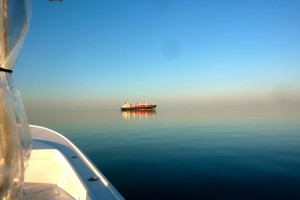 It’s been a windy December, so rough lately that it’s been hard to get out and fish. After yet another strong nor’easter blew through this week, the wind finally came down. Hoping for some cold weather catch & release action, my son Daniel and I broke the ice Wednesday and launched Thunder Road at the Shipping Creek ramp on Kent Island to do some Mid-Bay exploring. We didn’t find many fish – one twenty-four-inch striper to be exact – but we enjoyed our time on the water. The Chesapeake was as flat as I’ve ever seen it. We could see for miles across the glass. In places where we could get an unobstructed view of the horizon, we couldn’t tell where the water ended and the blue sky began. I’ve noticed that the waters of the Bay seem calmer and bluer on cold winter days. Sometimes I think I can see farther this time of year. It turns out there’s an interesting scientific explanation. Read More!
It’s been a windy December, so rough lately that it’s been hard to get out and fish. After yet another strong nor’easter blew through this week, the wind finally came down. Hoping for some cold weather catch & release action, my son Daniel and I broke the ice Wednesday and launched Thunder Road at the Shipping Creek ramp on Kent Island to do some Mid-Bay exploring. We didn’t find many fish – one twenty-four-inch striper to be exact – but we enjoyed our time on the water. The Chesapeake was as flat as I’ve ever seen it. We could see for miles across the glass. In places where we could get an unobstructed view of the horizon, we couldn’t tell where the water ended and the blue sky began. I’ve noticed that the waters of the Bay seem calmer and bluer on cold winter days. Sometimes I think I can see farther this time of year. It turns out there’s an interesting scientific explanation. Read More!
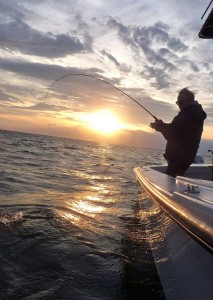 Savvy Chesapeake anglers recognize an event that happens every fall that has significant impact on light tackle fishing. In summer months, the waters in most areas of the Chesapeake Bay stratify so that it is cooler, denser, and saltier down deep, but lighter and fresher near the surface. In the fall, as temperatures cool and strong cold fronts bring lots of wind, the water is stirred up so that the top layer eventually reaches the same density as it is down deep. When that happens the surface water sinks so that for a while, temperatures and salinity are about the same top to bottom. It doesn’t happen all over the Bay at the same time, but it’s easily recognizable to fishermen because we start noticing that fish are feeding at much deeper depths. In some parts of the Maryland portion of the Bay, we are currently experiencing the fall turnover. This can be both good and bad for fishing.
Savvy Chesapeake anglers recognize an event that happens every fall that has significant impact on light tackle fishing. In summer months, the waters in most areas of the Chesapeake Bay stratify so that it is cooler, denser, and saltier down deep, but lighter and fresher near the surface. In the fall, as temperatures cool and strong cold fronts bring lots of wind, the water is stirred up so that the top layer eventually reaches the same density as it is down deep. When that happens the surface water sinks so that for a while, temperatures and salinity are about the same top to bottom. It doesn’t happen all over the Bay at the same time, but it’s easily recognizable to fishermen because we start noticing that fish are feeding at much deeper depths. In some parts of the Maryland portion of the Bay, we are currently experiencing the fall turnover. This can be both good and bad for fishing.
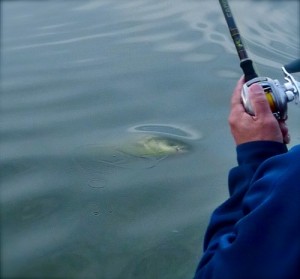 Like most Chesapeake Bay fishermen, my passion for fishing comes with a cost. I’m not speaking of tangibles like the money we put into gasoline, fishing lures, or repairing broken rods. That’s to be expected. The cost for the Chesapeake angler is worrying that the fish we love to catch may soon disappear. This week the Maryland Department of Natural Resources released its annual Young of the Year (YOY) Index. It’s an assessment of how many baby striped bass were produced the previous spring. This is the third year in a row that there has been less than normal reproduction. Marine biologists tell us there are a lot of reasons why the big fish aren’t making enough little fish. There are too many to list but it all boils down to one thing – uncertainty. We just don’t know what’s going on with our rockfish. The only thing we know for certain is that there will be a lot fewer fish for us to catch. Read More!
Like most Chesapeake Bay fishermen, my passion for fishing comes with a cost. I’m not speaking of tangibles like the money we put into gasoline, fishing lures, or repairing broken rods. That’s to be expected. The cost for the Chesapeake angler is worrying that the fish we love to catch may soon disappear. This week the Maryland Department of Natural Resources released its annual Young of the Year (YOY) Index. It’s an assessment of how many baby striped bass were produced the previous spring. This is the third year in a row that there has been less than normal reproduction. Marine biologists tell us there are a lot of reasons why the big fish aren’t making enough little fish. There are too many to list but it all boils down to one thing – uncertainty. We just don’t know what’s going on with our rockfish. The only thing we know for certain is that there will be a lot fewer fish for us to catch. Read More!
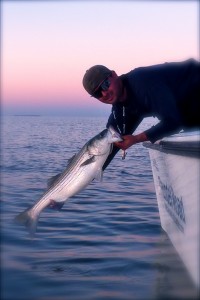 Since I’ve been reporting bigger migratory fish on my recent trips, I’ve been overwhelmed with questions about where the fish are. My apologies if I’ve yet to return a call or answer an email, but the absolute truth is – I don’t know. These big fish are moving around very quickly and they haven’t been at the same place twice. I think we sometimes put too much emphasis on locations, and not enough on patterns. Tell someone where to go to catch a fish and you may help them for a day, but teach them how to identify specific patterns of how fish behave, and you’ve helped them for a lifetime. Ask any good fisherman the secret to repeated success and he’ll tell you it’s the ability to distinguish specific feeding habits. I believe that you can drop a good fisherman into any body of water in the world and he’ll catch fish as long as you give him enough time to establish a prevailing pattern. It’s especially important on the Chesapeake where conditions change quickly and a rapid thirty degree temperature drop in October is not unusual. I think fishing conditions change faster and more often here than anywhere I’ve fished before. Fortunately, fish are usually creatures of habit and there are distinct patterns we can identify in the way they behave. Read More!
Since I’ve been reporting bigger migratory fish on my recent trips, I’ve been overwhelmed with questions about where the fish are. My apologies if I’ve yet to return a call or answer an email, but the absolute truth is – I don’t know. These big fish are moving around very quickly and they haven’t been at the same place twice. I think we sometimes put too much emphasis on locations, and not enough on patterns. Tell someone where to go to catch a fish and you may help them for a day, but teach them how to identify specific patterns of how fish behave, and you’ve helped them for a lifetime. Ask any good fisherman the secret to repeated success and he’ll tell you it’s the ability to distinguish specific feeding habits. I believe that you can drop a good fisherman into any body of water in the world and he’ll catch fish as long as you give him enough time to establish a prevailing pattern. It’s especially important on the Chesapeake where conditions change quickly and a rapid thirty degree temperature drop in October is not unusual. I think fishing conditions change faster and more often here than anywhere I’ve fished before. Fortunately, fish are usually creatures of habit and there are distinct patterns we can identify in the way they behave. Read More!
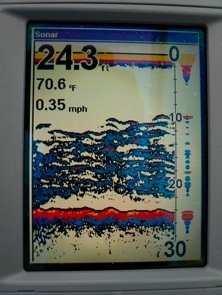 It’s sometimes said that good fishermen think like a fish. While no one really knows what fish think, it’s usually possible to predict where they might be located based on climatic conditions and the time of year. Two very important factors to consider when looking for fish in the Chesapeake Bay are water temperature and salinity. Sometimes stripers congregate near underwater structure, at other times they travel in schools out in the open bay, but they always prefer specific depth zones which vary depending on the time of year. Fish are cold-blooded, so they’re more likely to be active in water that keeps them warmer in the winter and cooler in the summer. The “perfect” water temperature for stripers is around 68 degrees, but perfect conditions are rare. Since locating feeding fish is a fisherman’s primary challenge, it’s important to understand seasonally changing temperature zones in the Bay.
It’s sometimes said that good fishermen think like a fish. While no one really knows what fish think, it’s usually possible to predict where they might be located based on climatic conditions and the time of year. Two very important factors to consider when looking for fish in the Chesapeake Bay are water temperature and salinity. Sometimes stripers congregate near underwater structure, at other times they travel in schools out in the open bay, but they always prefer specific depth zones which vary depending on the time of year. Fish are cold-blooded, so they’re more likely to be active in water that keeps them warmer in the winter and cooler in the summer. The “perfect” water temperature for stripers is around 68 degrees, but perfect conditions are rare. Since locating feeding fish is a fisherman’s primary challenge, it’s important to understand seasonally changing temperature zones in the Bay.
Salinity and temperature are closely related in the Bay. Striped bass are classified as anadromous fish, meaning they live primarily in salt water but migrate to fresh water to spawn. While they can live and thrive in fresh water, they prefer water with some salinity. Scientific opinions are mixed as to the optimum salt content, but there’s no denying that salinity influences the behavior of rockfish in the Bay. This is especially true in the spring and fall when many fish are traveling to and from the ocean. Read More!


